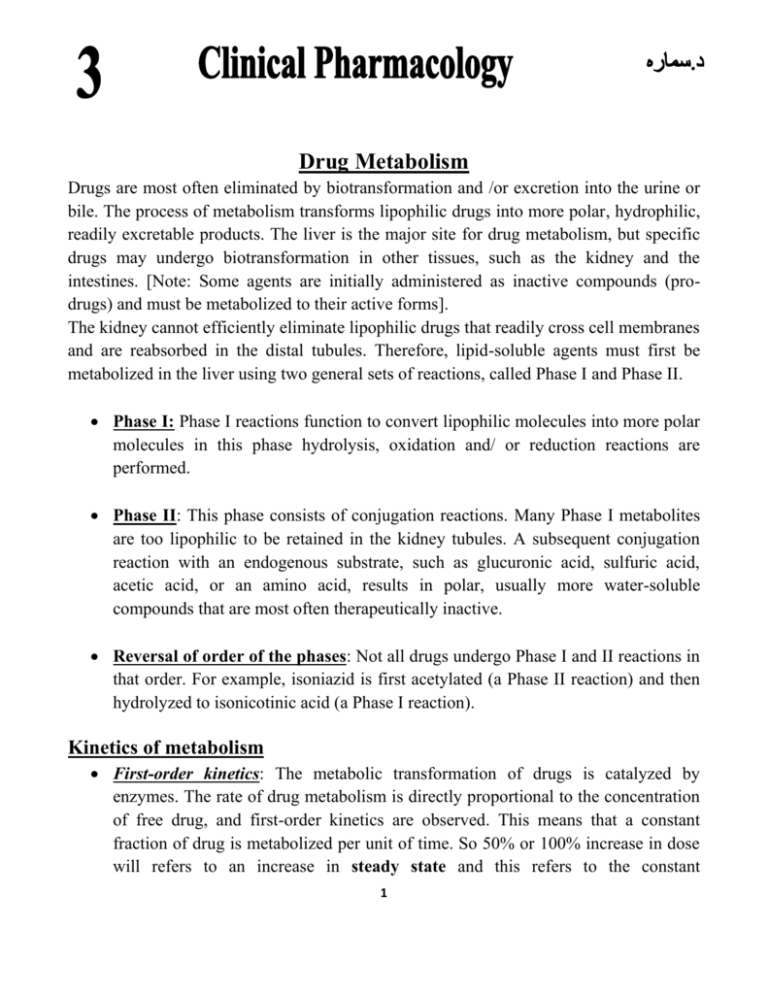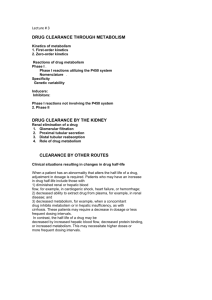Drug Metabolism
advertisement

Drug Metabolism Drugs are most often eliminated by biotransformation and /or excretion into the urine or bile. The process of metabolism transforms lipophilic drugs into more polar, hydrophilic, readily excretable products. The liver is the major site for drug metabolism, but specific drugs may undergo biotransformation in other tissues, such as the kidney and the intestines. [Note: Some agents are initially administered as inactive compounds (prodrugs) and must be metabolized to their active forms]. The kidney cannot efficiently eliminate lipophilic drugs that readily cross cell membranes and are reabsorbed in the distal tubules. Therefore, lipid-soluble agents must first be metabolized in the liver using two general sets of reactions, called Phase I and Phase II. Phase I: Phase I reactions function to convert lipophilic molecules into more polar molecules in this phase hydrolysis, oxidation and/ or reduction reactions are performed. Phase II: This phase consists of conjugation reactions. Many Phase I metabolites are too lipophilic to be retained in the kidney tubules. A subsequent conjugation reaction with an endogenous substrate, such as glucuronic acid, sulfuric acid, acetic acid, or an amino acid, results in polar, usually more water-soluble compounds that are most often therapeutically inactive. Reversal of order of the phases: Not all drugs undergo Phase I and II reactions in that order. For example, isoniazid is first acetylated (a Phase II reaction) and then hydrolyzed to isonicotinic acid (a Phase I reaction). Kinetics of metabolism First-order kinetics: The metabolic transformation of drugs is catalyzed by enzymes. The rate of drug metabolism is directly proportional to the concentration of free drug, and first-order kinetics are observed. This means that a constant fraction of drug is metabolized per unit of time. So 50% or 100% increase in dose will refers to an increase in steady state and this refers to the constant 1 concentration of drug that occurs after a small period of timed. The converse also will be true if drug dose deceases. When the drug discontinued the rate of elimination of drug from the plasma falls as the plasma of concentration falls. The time required for any plasma concentration of drug to fall by 50% is known as half- life of that drug (T1/2), the drugs undergo first- order kinetics in general needs 5 half-lives to be totally eliminated from the body as it needs 5 half lives to reach steady state. Zero-order kinetics: With a few drugs, such as aspirin, ethanol, and phenytoin, the doses are very large. As the amount of drug rises in the plasma, certain processes that have limited capacity become saturated i.e the rate of the process reaches maximum at which it remains constant due to limited amount of enzymes even if dose increases , so it is not proportional to the dose this is also called rate- limited ex. Ethanol alcohol in which T ½ is 1 hr. in a concentration below 10 m/dl. When the man drinks ¾ a cup it is easy to eliminate by enzymes into acetaldehyde while in drinking 375 ml it is subjected to zero order in which after 8 hr.s only 80 eliminated leaving 120 ml in the blood next morning. 2 Drug Elimination Removal of a drug from the body occurs via a number of routes, the most important being through the kidney into the urine. Other routes include the bile, intestine, lung, or milk in nursing mothers. A patient in renal failure may undergo extracorporeal dialysis, which removes small molecules such as drugs. Renal elimination of a drug Glomerular filtration: Drugs enter the kidney through renal arteries, which divide to form a glomerular capillary plexus. Free drug (not bound to albumin) are filtered quickly while bound drugs are poorly filtered. Proximal tubular secretion: in case of high lipid soluble drugs they are rapidly reabsorbed from the tubular urine, and they have to be metabolized into water- soluble form in order to be excreted but in case of water- soluble drug molecules, they can be excreted easily without metabolism. Metabolism of many drugs will result in less, but not completely lipid soluble form; these metabolites are less reabsorbed than parent drugs from the tubular lumen. [Note: Premature infants and neonates have an incompletely developed tubular secretory mechanism and, thus, may retain certain drugs in the glomerular filtrate.] Distal tubular reabsorption: Many drugs, being weak acids or weak bases, change their ionization with pH and this can markedly affect renal excretion. Basic drug is more rapidly excreted in acid urine. Conversely, acidic drugs are most rapidly excreted if the urine is alkaline. Urinary alkalinisation is used to accelerate the excretion of salicylate in treating selected cases of aspirin overdose. Role of drug metabolism: Most drugs are lipid soluble and without chemical modification would diffuse out of the kidney's tubular lumen. To minimize this reabsorption, drugs are modified primarily in the liver into more polar substances. Total body clearance The total body (systemic) clearance, CL total or CLt, is the sum of the clearances from the various drug-metabolizing and drug-eliminating organs. The kidney is often the major organ of excretion; however, the liver also contributes to drug loss through metabolism and/or excretion into the bile. A patient in renal failure may sometimes benefit from a drug that is excreted by this pathway, into the intestine and feces, rather than through the 3 kidney. Some drugs may also be reabsorbed through the enterohepatic circulation, thus prolonging their half-life. Total clearance can be calculated by using the following equation: CL total = CL hepatic +CL renal +CL pulmonary +CL others Clinical situations resulting in changes in drug half-life When a patient has an abnormality that alters the half-life of a drug, adjustment in dosage is required. It is important to be able to predict in which patients a drug is likely to have a change in half-life. The half-life of a drug is increased by:1) Diminished renal plasma flow or hepatic blood flow for example, in cardiogenic shock, heart failure, or hemorrhage. 2) Decreased extraction ratio for example, as seen in renal disease. 3) Decreased metabolism for example, when another drug inhibits its biotransformation or in hepatic insufficiency, as with cirrhosis. The half-life of a drug may decrease by:1) Increased hepatic blood flow. 2) decreased protein binding. 3) Increased metabolism. Kinetics of Continuous Administration Kinetics of IV infusion (I.V. infusion is continuous while I.V injection either single or repeated doses). With continuous IV infusion, the rate of drug entry into the body is constant. In the majority of cases, the elimination of a drug is first order; that is, a constant fraction of the agent is cleared per unit of time. Therefore, the rate of drug exit from the body increases proportionately as the plasma concentration increases, and at every point in time, it is proportional to the plasma concentration of the drug. 4 Steady-state drug levels in blood: Following the initiation of an IV infusion, the plasma concentration of drug rises until the rate of drug eliminated from the body precisely balances the input rate. Thus, a steady-state is achieved in which the plasma concentration of drug remains constant. [Note: The rate of drug elimination from the body = (CLt) (C), where CLt = total body clearance and C = the plasma concentration of drug.]. A steady-state plasma concentration of a drug occurs when the rate of drug elimination is equal to the rate of administration .Furthermore; the steady-state concentration is inversely proportional to the clearance of the drug, CLt. Thus, any factor that decreases clearance, such as liver or kidney disease, increases the steadystate concentration of an infused drug (assuming Vd remains constant). Factors that increase clearance of a drug, such as increased metabolism, decrease the steady-state concentrations of an infused drug. Effect of infusion rate on the steady-state concentration of drug in the plasma. (Ro = rate of infusion of a drug.) Effect of the dose of a single intravenous injection of drug on plasma levels 5 Rate of drug decline when the infusion is stopped: When the infusion is stopped, the plasma concentration of a drug declines (washes out) to zero with the same time course observed in approaching the steady state Loading dose: A delay in achieving the desired plasma levels of drug may be clinically unacceptable. Therefore, a loading dose of drug can be injected as a single dose to achieve the desired plasma level rapidly, so this (initial dose) is given to get the patient under the effect of the drug followed by an infusion to maintain the steady state (maintenance dose). Kinetics of fixed-dose/fixed-time-interval regimens Administration of a drug by fixed doses rather than by continuous infusion is often more convenient. However, fixed doses, given at fixed-time intervals, result in time-dependent fluctuations in the circulating level of drug Single IV injection: For simplicity, assume the injected drug rapidly distributes into a single compartment. Because the rate of elimination is usually first order in regard to drug concentration, the circulating level of drug decreases exponentially with time. [Note: The t1/2 does not depend on the dose of drug administered.] 6 Multiple IV injections: When a drug is given repeatedly at regular intervals, the plasma concentration increases until a steady state is reached. Because most drugs are given at intervals shorter than five half-lives and are eliminated exponentially with time. Therefore, the drug accumulates until, within the dosing interval, the rate of drug loss (driven by an elevated plasma concentration) exactly balances the rate of drug administration that is, until a steady state is achieved. Orally administered drugs: Most drugs that are administered on an outpatient basis are taken orally on a fixed-dose/fixed-time-interval regimen or example, a specific dose taken one, two, or three times daily. In contrast to IV injection, orally administered drugs may be absorbed slowly, and the plasma concentration of the drug is influenced by both the rate of absorption and the rate of drug elimination. Predicted plasma concentrations of a drug given by infusion (A), twice-daily injection (B), or once-daily injection (C). Model assumes rapid mixing in a single body compartment and a half-life of twelve hours. Predicted plasma concentrations of a drug given by repeated oral administrations 7








